American Atheism
 From Conservapedia
From Conservapedia 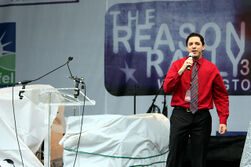
According to the 2014 General Social Survey (GSS), the number of atheists and agnostics in the United States has remained relatively stable in the past 23 years. In 2014, 3% of Americans identified as atheists, and 5% identified as agnostics.[2] In 1991, 2% of Americans identified as atheist, and 4% identified as agnostic.[3]
On July 24, 2019, due to religious immigration to the United States and the higher fertility rate of religious people, Eric Kaufmann wrote in an article entitled Why Is Secularization Likely to Stall in America by 2050? A Response to Laurie DeRose: "Overall, the picture suggests that the U.S. will continue to secularize in the coming decades. However, a combination of religious immigration, immigrant religious retention, slowing religious decline due to a rising prevalence of believers among the affiliated, and higher native religious birth rates will result in a plateauing of secularizing trends by mid-century." [4]
Darel E. Paul wrote at the First Things website:
| “ | Even without demographic models, survey data since the 1970s show that the percentage of Americans with a “strong” religious affiliation has not declined at all; it is the “weak” that have turned into “nones.” Moreover, immigration brings primarily religious people from the Global South into the Global North. In his earlier book, Kaufmann predicted that America’s secular high-water mark will occur around 2030; in Western Europe, no later than 2070. In Kaufmann’s view, religious identity will largely overpower ethnic identity a century hence, “with seculars and moderates of all backgrounds lining up against the fundamentalist sects.”[5] | ” |
Pew Research survey data indicates that the percentage of atheists in the United States has remained at 4% from 2015 to July 2019.[6]
In June 2016, American Interest reported: "First of all, religious belief is still very powerful and widespread, and there is nothing inevitable about its decline. In fact, the proportion of people who say they believe in God actually ticked modestly upward, from 86 percent to 89 percent, since Gallup last asked the question in 2014.[7]
The Pew Research Center reported in 2013: "The number of people who identify themselves as atheists in the United States has been rising, modestly but steadily, in recent years. Our aggregated data from 2012 show that 2.4% of American adults say they are atheists when asked about their religious identity, up from 1.6% in 2007."[8]
Post Elevatorgate (a July 2011 controversy in which Richard Dawkins was accused of misogny), there has been a lot of friction with the atheist movement (see: Atheist factions).
At the American Atheists 2018 convention, David Silverman, ex-president of the American Atheists organization, gave a speech entitled, "How the mighty get back up". The speech alluded to the pro-religious rights agenda of the Trump administration (See: Donald Trump and American atheists). During the speech Silverman said regarding American atheists, "We are suffering a level of defeatism that I have never seen before". (See: Decline of the atheist movement).[9] Later in 2018, Silverman was fired due to allegations of financial conflicts and sexual assault (see also: Atheism and sexism).[10]
At the 2018 American Atheists convention, the ex-president of the American Atheist organization David Silverman declared:
| “ | It is a hard time to be an atheist activist. This has affected us. And it has affected our community...
...it has really affected us. We are suffering a level of defeatism that I have never seen before... We feel the loss. And we feel like we have lost. We feel like we lost the election... We see this cascade of attack coming down at us over and over from all different directions and we feel like it's over. I have heard so many times it makes me sick. It makes me sad. It feels like we lost. The apathy that follows. It doesn't matter. We can't win anyways. It's useless to fight. This apathy is infecting us. It's hurting us. And people are reacting to each other now. And so that is causing a division. Lots and lots of division in our movement. Hard, bad division... And that has resulted in a splintering and factioning of the movement that I have never seen before and none of us have. In other words, we're in a bad situation and it's getting worse.[11] |
” |
Silverman was a new atheist. New Atheism is a form of militant atheism which was launched in 2006. Due to the Elevatorgate controversy and ongoing accusations of prominent new atheists engaging in Islamophobia, the New Atheism movement has waned (see also: Decline of militant atheism in the West and Richard Dawkins' loss of influence).[12][13]
On November 6, 2015, the New Republic published an article entitled, Is the New Atheism dead?[14]
In 2015, the atheist author Joshua Kelly wrote: "...since the death of Hitchens: angry atheism lost its most charismatic champion. Call it what you like: New Atheism, fire-brand atheism, etc., had a surge with the Four Horsemen in the middle of the last decade and in the last four years has generally peetered out to a kind that is more docile, politically correct, and even apologetic."[15]
In addition, Baylor University reported in 2015:
| “ | Recent coverage of American religious life, by focusing on the decline of some of the larger denominations and the new organized life of non-theistic communities, have missed the larger story that since World War II, religion in the United States has grown spectacularly and ahead of the population curve. America is now the most religious it has ever been with Church membership at an all-time high and relatively new worshiping communities representing the spectrum of the world's religions now spread across the urban landscape. As a nation in which the great majority of its people have affiliated with a religious community, without government coercion, America is possibly the most religious country that the world has ever seen.”[16] | ” |
For more information, see: Baylor University researchers on American Christianity
Liberal Christianity is shrinking in the United States and some of these individuals are becoming "nones"/religiously unaffialiated (only 7% if nones are atheists), others are embracing more conservative/fervent forms of Christianity and a small percentage are joining the atheists/agnostic camps.
American atheism: Low stature of American atheists in American society[edit]
Concerning various views on atheists, research in the American Sociological Review finds that among several groups listed, atheists are the group that Americans relate least to in terms of their vision of American society and are the group most likely to be mentioned as one that Americans would not want to have marry into their family. [17]
Dr. Sam Harris is a founder of the New Atheism movement. Sam Harris is quite aware of the stigma surrounding atheism and has even advocated that atheists no longer call themselves atheists.[18] In fact, Dr. Harris has said concerning the label of atheist, "It's right next to child molester as a designation."[19]
University of Minnesota indicates that American dislike of atheists grew[edit]
See also: University of Minnesota indicates that American dislike of atheists grew
A 2016 press release of a University of Minnesota study on atheists reported:
| “ | Survey data collected in 2014 shows that, compared to data collected in 2003, Americans have sharpened their negative views of atheists...
The findings of this most recent survey support the argument that atheists are persistent cultural outsiders in the United States because they are perceived to have rejected cultural values and practices understood as essential to private morality, civic virtue, and national identity. Moreover, any refusal to embrace a religious identity of any type is troubling for a large portion of Americans.[20] |
” |
American atheism and closet atheism[edit]
See also: Closet atheist
Dr. Ken Eisold wrote at Psychology Today about American atheism: "The FT reporter commented: 'As I found out when I travelled across the US last year, atheists live in isolation and secrecy all over the country.'"[21]
Sociology of "atheism is un-American" view[edit]
See also: Sociology of "atheism is un-American" view
The 2013 Freedom of Thought report published the International Humanist and Ethical Union indicates: "...the U.S. has long been home to a social and political atmosphere in which atheists and the non-religious are made to feel like lesser Americans or non-Americans."[22]
Charles Louis Richter declared in his interview with the International Society for Historians of Atheism, Secularism, and Humanism (ISHASH) about America and atheism:
| “ | The turn of the century ended the golden age of nineteenth century freethought with two events: the death of Robert Ingersoll in 1899, and the assassination of President William McKinley in 1901. The lack of a widely popular voice for irreligion, combined with the murder of the president by an anarchist, led to a backlash against not only anarchism but also atheism. From that point, Americans tended to see irreligion in terms of whatever ostensibly foreign ideology seemed most threatening. So for the rest of the century, we see atheism and atheists associated with anarchism, fascism, socialism, and of course Soviet-style communism. By the late seventies, secular humanism became the buzzword for a whole suite of threats not only to religion, but to Americanism. It’s important to note that this phenomenon is not limited to the political or religious right; liberals also framed irreligion as un-American.[23] | ” |
The sociologist Phil Zuckerman, who is an atheist, wrote in his Psychology Today article Why Americans Hate Atheists:
| “ | 1. Americans equate a lack of religiosity in general – or atheism specifically – with immorality.
2. Americans equate a lack of religiosity in general – or atheism specifically – with being un-American and/or unpatriotic. 3. There is no stigma concerning the expressed dislike of the non-religious. While there is a stigma (to varying degrees, depending on one’s social milieu) attached to being racist, or anti-Semitic, or Islamophobic... – there has never existed a social or cultural backlash against people who openly express disdain for secular folks. So people simply feel much more comfortable expressing their dislike for atheists than, say, Latinas/os or women.[24] |
” |
Ineffectualness of the American atheism movement[edit]
See also: Decline of the atheist movement and Atheist movement and Atheism and politics and Views on atheists
An American speaker in the atheist panel discussion "Where do we go from here?" at Reason in the Rock 2013 declared: "We are still culturally and politically marginal. We still don't have very much influence... We are ineffective."[25]
Atheism in America: Demographics and trends in American secularism[edit]
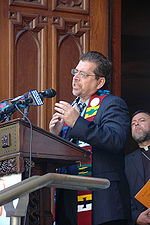
See also: United States, irreligion vs. religion and demographics and Demographics of atheism and Demographics of agnosticism
Professor Eric Kaufmann, Birkbeck College, University of London, specializes on how demographics affects religion/irreligion/politics.
Steve Turley wrote:
| “ | According to a recent a demographic study by University of London Professor Eric Kaufmann, there is a significant demographic deficit between secularists and conservative religionists. For example, in the U.S., while self-identified secular women averaged only 1.5 children per couple in 2002, conservative evangelical women averaged 2 to 3 children per couple, which amounts to a 28 percent fertility advantage. Now Kaufmann notices that this demographic deficit has dramatic effects over time. In a population evenly divided, these numbers indicate that conservative evangelicals would increase from 50 to 62.5 percent of the population in a single generation. In two generations, their number would increase to 73.5 percent, and over the course of 200 years, they would represent 99.4 percent.
Kaufmann noticed further that the more religiously conservative, the more children. For example, the Amish double in population every twenty years, and are projected to number over a million in the U.S. and Canada in just a few decades. We're seeing a similar trend among Mormons, who have averaged a 40 percent growth per decade, which means that by the end of the century, there will be as many as 300 million Mormons in the world, or six percent of the world's population. And note: Mormons vote overwhelmingly Republican. Now in stark contrast to all of this, Kaufmann's data projects that secularists consistently exemplify a low fertility rate of around 1.5 percent per couple, which is significantly below the replacement level of 2.1 percent. And so he sees a steady decline of secular populations after 2030 or 2050 to potentially no more than a mere 14 to 15 percent of the American population. He notices that similar projections apply to Europe as well.[28] |
” |
In 2012, Kaufmann wrote:
| “ | In the United States, they manage 1.5, considerably lower than the national 2.1. This disadvantage is not enough to prevent religious decline in much of Europe and America today, but secularism must run to stand still. Since the history of religious decline in Europe suggests that secularization rates tend to drop over time, this portends the end of secularization. Projections I recently published with Skirbekk and Goujon in the journal Sociology of Religion show secularism losing momentum and beginning to decline in both Europe and America by 2050, largely because of low fertility and religious immigration.[29] | ” |
Regarding the Western World as a whole and the growth of the religious population in the West, Kaufmann wrote:
| “ | ...this paper claims that the developing world will not only never catch up, but that, ironically, it is the West which will increasingly come to resemble the developing world. Committed religious populations are growing in the West, and will reverse the march of secularism before 2050. The logic which is driving this apparently anti-modern development is demography, a shadowy historical force whose power multiplies exponentially with the modernisation process. Demography is about raw numbers, and, in an age of low mortality, its chief components are fertility and migration.[30] | ” |
Kaufmann wrote about irreligion/irreligion and the culture war in America:
| “ | High evangelical fertility rates more than compensated for losses to liberal Protestant sects during the twentieth century. In recent decades, white secularism has surged, but Latino and Asian religious immigration has taken up the slack, keeping secularism at bay. Across denominations, the fertility advantage of religious fundamentalists of all colours is significant and growing. After 2020, their demographic weight will begin to tip the balance in the culture wars towards the conservative side, ramping up pressure on hot-button issues such as abortion. By the end of the century, three quarters of America may be pro-life. Their activism will leap over the borders of the 'Redeemer Nation' to evangelize the world. Already, the rise of the World Congress of Families has launched a global religious right, its arms stretching across the bloody lines of the War on Terror to embrace the entire Abrahamic family.[31] | ” |
Kaufmann, who is an agnostic, wrote about the higher fertility rate of the religious right, "Furthermore, the demography of the nation suggests that God may ultimately be on the side of the Religious Right."[32]
Demographic research indicating that religiosity in the United States may experience growth[edit]
In 2013, citing experts in demography and survey data, the Christian Post declared that there were three trends pointing to the United States potentially becoming more religious in coming years - namely an aging population becoming more religious over time, religious immigrants and the higher fertility rate of religious conservatives.[33]
Hispanic evangelicalism[edit]
See also: Atheism and Latino Americans
Due to Hispanic evangelicals, church attendance was up in New York City in 2013.[34]
With the continued rise in the number of Hispanic, evangelical Christians in North America and the rise of evangelicalism in Latin America and South America, secular leftism is not going to be dominant in America's future.[35]
Hispanics and the future of religion/irreligion in the United States[edit]
- Rise Of Hispanic Evangelical Church: Time Magazine Discusses Influence Of Latinos In America's Religion, Huffington Post, April 11, 2013
- The Rise of Evangélicos By Elizabeth Time magazine, April 4, 2013
- Switching Sides: Latinos Ditching Catholicism For Evangelical Churches
- Hispanics turning evangelical, Jews secular, Beliefnet.com, November 2013
- Hasta luego, American godless progressivism! Worship service attendance is up in New York City amigos!, November 7, 2013
- The writing is on the wall amigos: Godless progressivism will not be dominant in the USA's future, August 14, 2013
Eric Kaufmann, Vegard Skirbekk and Anne Goujon religion/irreligion demographic projections[edit]
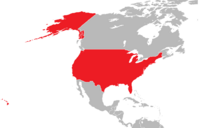
In their 2010 journal article entitled, Secularism, Fundamentalism or Catholicism? The Religious Composition of the United States to 2043 published in the Journal for the Scientific Study of Religion, Eric Kaufmann, Vegard Skirbekk and Anne Goujon wrote:
| “ | We find considerable stability of religious groups over time, but there are some important shifts. Hispanic Catholics experience the strongest growth rates to 2043. Immigration, high fertility, and a young age structure will enable this group to expand from 10 to 18 percent of the American population between 2003 and 2043, despite a net loss of communicants to secularism and Protestantism. This will power the growth of Catholics as a whole, who will surpass Protestants by mid century within the nation’s youngest age groups. This represents a historic moment for a country settled by anti-Catholic Puritans, whose Revolution was motivated in part by a desire to spread dissenting Protestantism and whose populationon the eve of revolution was 98 percent Protestant (Huntington 2004; Kaufmann 2004). Another important development concerns the growth of the Muslim population and decline of the Jews. High Muslim fertility and a young Muslim age structure contrasts with low Jewish childbearing levels and a mature Jewish age structure. Barring an unforeseen shift in the religious composition and size of the immigrant flow, Muslims will surpass Jews in the population by 2023 and in the electorate by 2028. This could have profound effects on the course of American foreign policy. Within the non-Hispanic white population, we expect to see continued Liberal Protestant decline due to low fertility and a net loss in exchanges with other groups. White Catholics will also lose due to a net outflow of converts. Fundamentalist and Moderate Protestant denominations will hold their own within the white population, but will decline overall as the white share of the population falls.
The finding that Protestant fundamentalism may decline in relative terms over the medium term contrasts with a prevailing view that envisions the continued growth of “strong religion” (Stark and Iannaccone 1994a). This is the result of an older age structure, which increases loss through mortality, and immigration, which reduces the size of all predominantly white denominations — all of which are poorly represented in the immigration flow. Fundamentalists’ relatively high fertility and net surplus from the religious marketplace is not sufficient to counteract the effects of immigration. Obviously, this could change if significant immigration begins to arrive from more Pentecostalist source countries such as Guatemala or parts of sub-Saharan Africa. Our work also sheds light on the religious restructuring paradigm, though we do not find a clear victor between secularism and fundamentalism. The secular population will grow substantially in the decades ahead because it has a young age structure and more people leave religion than enter it. The sharpest gains for secularism will be within the white population, where seculars will surpass fundamentalists by 2030. On the other hand, there are important demographic limits to secularism, demonstrating the power of religious demography. The relatively low fertility of secular Americans and the religiosity of the immigrant inflow provide a countervailing force that will cause the secularization process within the total population to plateau before 2043. This represents an important theoretical point in that demography permits society to become more religious even as individuals tend to become less religious over time.[37] |
” |
According to British author Edward Dutton, religious people are more likely to migrate (there are various reasons postulated, but it remains unclear why this is so).[38] See also: Religion and migration
For more information, please see: Growth of evangelicalism in the world and in the United States and American culture war, demographics and expected tipping point after 2020
In 2022, Pew Research reported: {{Cquote|Looking at the experience of 80 countries, we find that the share of people who were raised as Christians and switch away from Christianity has not risen much above 50% anywhere, even in highly secular Western European countries. For American Christians concerned about these trends, that could be the demographic good news of the day. If there truly is a floor under Christian retention rates, the net movement from the ranks of Christian to the ranks of the religiously unaffiliated eventually may stop.[39]
Fertility rates, secularism, religiosity and future U.S. trends[edit]
See: Ellis, Hoskin, Dutton and Nyborg journal article on fertility and secularism in the United States and in developed countries
Journal of Contemporary Religion on schisms within U.S. atheism[edit]
See also: Atheist factions and Atheist movement
The Journal of Contemporary Religion says about schisms within atheism: "The persistence of internal schisms and regular outbreaks of in-fighting within the atheist movement also ensure that much energy is effectively wasted on parochial concerns and further undermine attempts to establish a genuine sense of group cohesion."[40]
The Journal of Contemporary Religion say that internal divisions within the American atheist movement have to do with:
| “ | internal divisions within the movement around issues relating to goals, strategies, and direction. These can be seen most notably in debates about the formation of a collective ‘atheist’ identity, in disputes about the effectiveness of confrontationalism and accommodationism, and in concerns about the movement’s ethnic, racial, and gender profile.[41] | ” |
Atheist activist Lee Moore: Donations to American atheist organizations are down due to infighting within the atheist movement[edit]
See also: Atheist fundraising vs. religious fundraising and Atheist factions and Atheism and social skills
In 2017, the atheist activist Lee Moore declared about American atheist organizations:
| “ | If you look at the major atheist groups right now, like the national groups, the ones that are doing the real activist work... They are not bringing in the kind of donations they used to. Most of them are starved for cash. They're downsizing left and right. Because people aren't just giving like they used to. And I talked to a lot of the major donors out there and they said, "Well, we're kind of tired of seeing the atheist community just fight amongst itself and not really get anything done. We'd rather not give money if we don't think it's going to go somewhere."[42] | ” |
Atheist James Coft on a deepening rift between American atheists[edit]
The atheist James Croft wrote about American atheism:
| “ | ...something has happened to organized secularism, such that its priorities and population have rapidly changed. Today, there is a deepening rift between two wings of the movement, and the changes in Skepticon demonstrate this perfectly. The new rift in the secular community, it seems to me, parallels one deepening in the culture at large: it is between those who are on board with contemporary social justice culture, and those who are not.
In the community of skeptics, this rift is filled with lava: there is an incredibly intense animosity between those on different sides, and the divide seems impossible to cross.[43] |
” |
[edit]
See also: Atheist factions and Atheists and antisocial behavior
The forerunner of the feminist Atheism plus movement was the online Elevatorgate controversy involving new atheist Richard Dawkins and feminist Rebecca Watson.
The Guardian wrote about Atheism plus and the reaction of many atheists on the internet:
| “ | In the passionate world of American atheism, the venom usually directed at believers has now been turned against the wrong kind of atheists...
It took 700 years from Constantine renaming Byzantium in his own honour to papal legates circulating letters of anathema that split the Roman and Orthodox churches. Atheism, in its public, online life, has started exchanging internet anathemas – perhaps we should call them inathemas – in little more than a decade.[44] |
” |
Post Elevatorgate and Atheism plus, the conflict between atheist feminism and anti-feminism atheists continues. Two of the most anti-feminism atheists are YouTube atheists Thunderf00t and TheAmazingAtheist.
Atheist feminist David Silverman scandal[edit]
See also: Atheist organizations and scandals and Atheist hypocrisy
David Silverman served as the President of the American Atheists organization.[45] After leaving two atheist organizations amid sexual harassment allegations, Silverman now calls himself a former atheist activist (see: David Silverman's loss of public influence).[46] See: Firing of David Silverman from the American Atheists organization.
In his book, Fighting God, Silverman indicates that he is a “proud feminist.”[47] See also: Atheism and sexism
Concerning Silverman's scandals and subsequent firing, atheist and feminist PZ Myers said, "It's a terrible day for organized atheism."[48] Myers spent $1200 for a lifetime membership with American Atheists because he was impressed by the way Silverman went after the “anti-feminist” atheists.[49] See also: Decline of the atheist movement
David Silverman declares he is a former atheist activist[edit]
See also: David Silverman's loss of public influence

Composition and structure of the American atheist movement[edit]
See also: Atheist organizations
The Journal of Contemporary Religion says about the composition and structure of the American atheist movement:
| “ | The organisational structure of the atheist movement is characterised by plurality and eclecticism. Based around no predominant group and possessing no formal leadership or tangible set of governing arrangements, this movement assumes a non-hierarchical and decentralised form that operates within a number of organisations set up to promote a range of atheist, secularist, and humanist (collectively referred to here as ‘ASH’) ideas and causes. Notable organisations include: the American Humanist Association (established in 1941), American Atheists (formed in 1963), the Freedom From Religion Foundation (1978), the Council for Secular Humanism (1980), the Atheist Alliance of America (1991), the Center for Inquiry (1991), the Military Association of Atheists and Freethinkers (1998), the Secular Student Alliance (2000), the Secular Coalition for America (2002), and the United Coalition of Reason (2009).
At the present time, little is known about the specific composition of such groups and the reasons why individuals become actively involved in the atheism movement are still being debated (e.g. LeDrew). Research suggests that a majority of atheists positively engage in efforts to promote atheism in some form (Silver), but it appears that only a small percentage become involved in formal organisations of this kind. Research also indicates that atheists who are actively participating in formal non-religious organisations tend to belong to a number of different groups at any one time (Hunsberger and Altemeyer).[50] |
” |
Leading American atheist organizations lean to the left politically[edit]
According to Republican Atheists' President Lauren Ell, the leading atheist organizations such as American Atheists, Freedom From Religion Foundation and Secular Student Alliance lean left politically.[51]
Google trends USA data from 2004 to January 2020[edit]
See also: Internet atheism and Google trends - Atheism and agnosticism terms
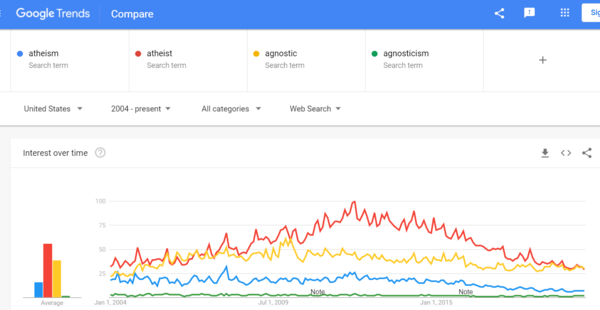
Atheist Eddie Tabash on the American atheist movement[edit]
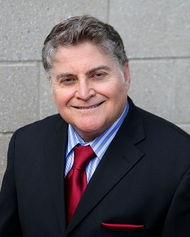
The American atheist activist Eddie Tabash said at the 2010 Michigan Atheists State Convention:
| “ | In every generation there has been a promising beginning of a true vanguard movement that will finally achieve widespread public acceptance for nonbelief. Yet, in each generation there has been an ultimately disappointing failure to actually register the naturalistic alternative to supernatural claims in the public consciousness...
Now given the confounding extent to which religion is entrenched in our society, it could take a minimum of 100 years of sustained, intense effort to even begin to cut into the current monolithic stranglehold that religion has on American mass culture, [52] |
” |
Tabash's proposal for gains in atheist acceptance unrealistic[edit]
The likelihood that American atheists will engage to 100 years of sustained, intense effort as far as atheist activism is remote (See: Atheism and apathy and Views on atheists).
Pew Research reported about the American public:
| “ | In the 2014 Religious Landscape Study, self-identified atheists were asked how often they share their views on God and religion with religious people. Only about one-in-ten atheists (9%) say they do at least weekly, while roughly two-thirds (65%) say they seldom or never discuss their views on religion with religious people. By comparison, 26% of those who have a religious affiliation share their views at least once a week with those who have other beliefs; 43% say they seldom or never do.[53] | ” |
In addition, demographic trends point to the atheist population in the United States plateauing in the 21st century as far its proportion of the American public (see: Demographic trends in American secularism).
Also, a 100-year sustained and intense effort of atheist activism would require a high degree of cohesiveness and cooperation among atheists. Tabash said in a speech to the Michigan Atheists State Convention, "Since we are a bit of a cantankerous, opinionated lot...".[54] See also: Atheist factions and Atheism and social skills
Furthermore, due to various historical events/trends, the atheist movement saw a number of setbacks during the latter portion of the 20th century and beyond. As a result, it has lost a considerable amount of confidence (See: Atheists and the endurance of religion).[55]
American study on the six types of atheists[edit]
A University of Tennessee at Chattanooga study of non-believers found that there are 6 types of atheists/agnostics/non-believers: atheists/agnostics who are more intellectually minded (38% of total sample); non-believer political activists who commonly get involved in leftist/political causes more than atheist activism (23% of non-believers, most atheists lean toward the left end of the political spectrum, see Atheism and politics); Anti-Theist (This vocal group often gets conflated with all atheists by believers, but they merely constitute 15 percent of non-believers); Seeker-Agnostic (makes up 7.6 percent of non-believers) and Non-Theist (apathetic and is only 4.4 percent of non-believers).[56]
- See also: Antitheism and antisocial behavior
American atheists and IQ scores/intelligence[edit]
- American atheism and intelligence
- Atheism, intelligence and the General Social Survey
American atheists and loneliness[edit]
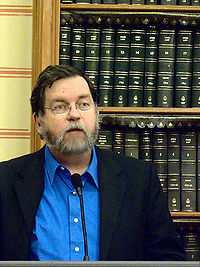
See also: Atheism and loneliness and Atheism and arrogance and Atheism and anger and Atheism and bitterness
As noted above, Americans typically have a very negative view of atheists and they are often seen as lacking moral character and very arrogant (see also: Views on atheists and Atheism and morality and Atheist population and immorality and Atheism and arrogance).
In his article entitled The Lonely Life of an American Atheist, Alfred Garcia wrote:
| “ | ...life remains hard for non-theists in the United States. There is, of course, the cultural stigma—of being nontheistic in a nation where more than 90 percent of people believe in a higher power. There is only one openly atheist member of Congress, Rep. Peter Stark from California (who had a video appearance at the Reason Rally). Atheists are viewed more negatively than any other U.S. religious group, with less than half of Americans (45 percent) holding a favorable opinion of them. It can be a lonely existence. With no single umbrella organization to bring non-theists together, individuals can feel isolated, compounded by the fact that the various non-theist organizations are often fragmented in their approaches....
What has not changed much, though, is the image of the non-theist that O’Hair left in her wake. It’s the image of the atheist out to pick a fight, the unbeliever who is constantly seeking the next debate. As Fidalgo from CFI put it, O’Hair was an “extremely polarizing” figure who “gained visibility for American Atheists but may have been integral in forming the image of atheism in the U.S. as arrogant.”[57] |
” |
Contents
- 1 American atheism: Low stature of American atheists in American society
- 1.1 University of Minnesota indicates that American dislike of atheists grew
- 1.2 American atheism and closet atheism
- 1.3 Sociology of "atheism is un-American" view
- 2 Ineffectualness of the American atheism movement
- 3 Atheism in America: Demographics and trends in American secularism
- 3.1 Demographic research indicating that religiosity in the United States may experience growth
- 3.2 Hispanic evangelicalism
- 3.2.1 Hispanics and the future of religion/irreligion in the United States
- 3.3 Eric Kaufmann, Vegard Skirbekk and Anne Goujon religion/irreligion demographic projections
- 3.4 Fertility rates, secularism, religiosity and future U.S. trends
- 4 Journal of Contemporary Religion on schisms within U.S. atheism
- 4.1 Atheist activist Lee Moore: Donations to American atheist organizations are down due to infighting within the atheist movement
- 4.2 Atheist James Coft on a deepening rift between American atheists
- 5 American atheism and atheist feminism related schism
- 5.1 Atheist feminist David Silverman scandal
- 5.1.1 David Silverman declares he is a former atheist activist
- 5.1 Atheist feminist David Silverman scandal
- 6 Composition and structure of the American atheist movement
- 7 Leading American atheist organizations lean to the left politically
- 8 Google trends USA data from 2004 to January 2020
- 9 Atheist Eddie Tabash on the American atheist movement
- 9.1 Tabash's proposal for gains in atheist acceptance unrealistic
- 10 American study on the six types of atheists
- 11 American atheists and IQ scores/intelligence
- 12 American atheists and loneliness
- 13 American atheist activists exaggerating the number of atheists in the United States
- 13.1 Atheist Jacques Berlinerblau on American atheist movements
- 14 Hate crimes in the United States against atheists/agnostics are very low in number
- 15 Atheists in America: Claims of being an oppressed minority
- 16 Reason Rally
- 17 Lack of significant outreach to racial minorities in the Western World
- 18 Donald Trump and American atheists
- 19 See also
- 20 External links
- 21 References
American atheist activists exaggerating the number of atheists in the United States[edit]
See also: Atheist movement
In 2012, the organization PolitiFact Rhode Island accused American Atheists president David Silverman of wildly exaggerating the number of atheists in America by attempting to included the Unaffiliated (also called Nones) who made up about 15% of the United States population at the time (despite the fact that only 15 percent of "nones" identify as atheists) and by also attempting to lump agnostics with the atheist population.[58][59]
According to PolitiFact Rhode Island: "When the American Religious survey asked people what they thought of the existence of God, 2.3 percent said 'There is no such thing.'...When Pew asked a broader question -- "Do you believe in God or a universal spirit?" -- 5 percent said "No.""[60]
The 2008 American Religious Identification Survey (ARIS) found that only 0.7% of U.S. adults identified as atheist, but at the same time 2.3% said there is no such thing as a god.[61] The reluctance of Americans to self-identify as atheists is likely due to the American public's low opinion of atheists (See: Americans have a low opinion of atheists).
- See also: David Silverman intentionally exaggerating the number of atheists in the USA
Atheist Jacques Berlinerblau on American atheist movements[edit]

The atheist Georgetown professor Jacques Berlinerblau declared:
| “ | American atheist movements, though fancying themselves a lion, are more like the gimpy little zebra crossing the river full of crocs. In terms of both political gains and popular appeal, nonbelievers in the United States have little to show. They are encircled by cunning, swarming [religious] Revivalist adversaries who know how to play the atheist card. The gimpy zebra remark was a little goofing on this over-the-top chest-thumping that emerges from Movement Atheists. They wildly overestimate their numbers. They tend to overestimate the efficacy of their activism. They underestimate how disciplined and organized their adversaries in the religious right are, too. They fail to recognize that mocking religious people in public is entirely inimical to the goals they wish to achieve."[63] | ” |
Hate crimes in the United States against atheists/agnostics are very low in number[edit]
See also: Persecution of atheists and Atheism statistics
According to a 2007 Pew Forum survey, about 4% of Americans are atheists/agnostics.[64] A 2008 Gallup poll showed that 6% of the U.S. population believed that no god or universal spirit exists.[65]
According to 2013 FBI statistics, 6/10 of a percent of hate crimes were against atheists/agnostics.[66][67]
Atheists in America: Claims of being an oppressed minority[edit]
See also: Atheism vs. Christianity
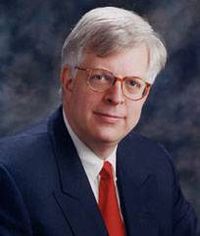
In the United States, a significant amount of atheists are white males and the American atheist population has been criticized for its lack of racial diversity and lower amount of females in its population (Western atheism and race and Atheism and women). The Pew Research Forum reported in 2013 concerning American atheists: "About four-in-ten atheists (43%) have a college degree, compared with 29% of the general public."[69] In 2012, the Pew Research Forum reported regarding American atheists: "And about 38% of atheists and agnostics have an annual family income of at least $75,000, compared with 29% of the general public."[70] Also, atheists within the United States have developed a reputation of uncharitableness as they gave far less to charities, even if church donations are not counted (see: Atheism and uncharitableness). As a result of these factors, claims of being an oppressed minority by atheists are often not taken seriously even by fellow atheists (For more information, please see: Atheist whining and Persecution of atheists).[71]
In addition, given the favorable treatment atheist activists often receive in the media and the atheistic indoctrination that occurs in public schools/universities, the notion of atheists as an oppressed minority is often rejected by Americans.
At the same time, in America as in many theistic societies, atheists are the least trusted group and many Americans have a low opinion of atheism/atheists (see: Views on atheists and Atheism and social outcasts).
Historically, many Christians have shown a significant amount of patience/tolerance towards atheists - even in face of persecution by atheists (see: Christian patience, forgiveness and long-suffering towards atheists).
Reason Rally[edit]
The Reason Rally was billed as the largest secular event in history.[72] It was held in the National Mall in Washington, D.C. on March 24, 2012.
According to the Religion News Service 8,000-10,000 people showed up for the rally.[73] The Atlantic reported 20,000 individuals were in attendance.[74]
Although the event was billed as the largest secular event in world history, strictly speaking that is not accurate. Communist countries have embraced state atheism. And Marxist-Leninism along with Maoism explicitly adhered to the atheist worldview and communist countries have engaged in militant atheism and religious persecution (see: Atheism and communism).[75] China still engages in religious persecution. Communist countries often had large/massive rallies. For example, at Tiananmen Square during the Cultural Revolution, the atheist Mao Zedong greeted 1,500 Red Guards and waved to 800,000 Red Guards and spectators below. [76]
Lack of significant outreach to racial minorities in the Western World[edit]
See also: Western atheism and race
The atheist community has not had significant outreach to racial minorities within the Western World whereas Christians have done this (particularly among the poor).[77] The atheist Sikivu Hutchinson declared “If mainstream freethought and humanism continue to reflect the narrow cultural interests of white elites who have disposable income to go to conferences then the secular movement is destined to remain marginal and insular.”[78]
In the United States, the Hispanic population is expected to triple by the year 2050 and become 30% of the United States population.[79]
Donald Trump and American atheists[edit]
See also: Donald Trump and American atheists

The Religion News Service reported:
| “ | For the last decade, atheists, humanists and others secularists have worked hard to organize a “secular vote” that would counter the political clout of the religious right.
President-elect Donald J. Trump’s victory dealt that movement a body blow when he garnered 81 percent of the white evangelical vote and 60 percent of the white Catholic vote. Mormons, too, voted overwhelmingly for Trump. Despite Trump’s not being a particularly religious person, his platform was seen as anti-secular in many atheist and humanist circles. He said he would appoint religiously conservative Supreme Court justices, ban Muslim immigrants, favor Christianity and repeal the Johnson Amendment, which prohibits certain tax-exempt organizations from endorsing political candidates — issues antithetical to organized atheism and humanism.[80] |
” |
The U.S. Supreme Court Justice Brett Kavanaugh, who was appointed by Trump, is a judge who has ruled in favor of religious liberty in his past decisions.[81] U.S. Supreme Court Justice Neil Gorsuch, who was also nominated to the court by Trump, gave a favorable ruling in the Hobby Lobby case in respect to religious liberty.[82] See also: Morale of the atheist movement
See also[edit]
- American secular leftism and Christian backlash
- Atheism in the Anglosphere
- Secular left
- Atheists and church attendance
- Canada and irreligion
- Atheist Population
- Global atheism
- Evolution
- Atheist whining
Essay:
- 10 reasons why American atheism will see a significant decline
External links[edit]
- Secularization will plateau in the United States sooner than some scholars expected
- 3 Reasons America May Become More Religious By Napp Nazworth, Christian Post, August 22, 2013
References[edit]
- ↑ This Firebrand Atheist Was Just Fired After Allegations Of Financial Conflicts And Sexual Assault
- ↑ Hout, Michael; Smith, Tom (March 2015). "Fewer Americans Affiliate with Organized Religions, Belief and Practice Unchanged: Key Findings from the 2014 General Social Survey" (PDF). General Social Survey. NORC
- ↑ Hout, Michael; Smith, Tom (March 2015). "Fewer Americans Affiliate with Organized Religions, Belief and Practice Unchanged: Key Findings from the 2014 General Social Survey" (PDF). General Social Survey. NORC
- ↑ Why Is Secularization Likely to Stall in America by 2050? A Response to Laurie DeRose by Eric Kaufmann July 24, 2019
- ↑ THE FUTURE IS MIXED by Darel E. Paul, First Things website
- ↑ In U.S., Decline of Christianity Continues at Rapid Pace, Pew Research
- ↑ Atheism is Rising, But…, American Interest
- ↑ Facts about atheists
- ↑ David Silverman - How the Mighty Get Back Up
- ↑ This Firebrand Atheist Was Just Fired After Allegations Of Financial Conflicts And Sexual Assault
- ↑ David Silverman - How the Mighty Get Back Up
- ↑ Is the New Atheism dead? by Elizabeth Bruenig, New Republic, November 6, 2015
- ↑ Uproar Against Dawkins Is Sign of New Atheism Retrogression by Joshua Kelly
- ↑ Is the New Atheism dead? by Elizabeth Bruenig, New Republic, November 6, 2015
- ↑ Uproar Against Dawkins Is Sign of New Atheism Retrogression by Joshua Kelly
- ↑ Scholars Will Challenge “Secularization Myth” Nov. 10 at National Press Club
- ↑ Edgell, Gerteis & Hartmann 2006
- ↑ http://newsinitiative.org/story/2007/06/19/interview_with_an_atheist
- ↑ http://newsinitiative.org/story/2007/06/19/interview_with_an_atheist
- ↑ Atheists Remain Most Disliked Religious Minority in the US
- ↑ The Fear of Atheism: One Nation Under God by Dr. Ken Eisold, Psychology Today
- ↑ 2013 Freedom of Thought by International Humanist and Ethical Union
- ↑ ISHASH MEMBER INTERVIEW: CHARLES LOUIS RICHTER, International Society for Historians of Atheism, Secularism, and Humanism
- ↑ Why Americans Hate Atheists by Phil Zuckerman
- ↑ Where does the Secular movement go from here?: Panel Discussion at Reason in the Rock 2013, YouTube video
- ↑ Hispanics turning evangelical, Jews secular, Beliefnet.com, November 2103
- ↑
- 3 Reasons America May Become More Religious By Napp Nazworth, Christian Post, August 22, 2013
- The writing is on the wall amigos: Godless progressivism will not be dominant in the USA's future, August 14, 2013
- Hispanics turning evangelical, Jews secular, Beliefnet.com, November 2013
- Rise Of Hispanic Evangelical Church: Time Magazine Discusses Influence Of Latinos In America's Religion, Huffington Post, April 11, 2013
- The Rise of Evangélicos By Elizabeth Time magazine, April 4, 2013
- ↑ Feminist Futility: Why the Women's March Promises a Conservative Future by Steve Turley, Christian Post
- ↑ The Future Will Be More Religious and Conservative Than You Think by Eric Kaufmann, American Enterprise Institute
- ↑ Shall the Religious Inherit the Earth?: Demography and Politics in the Twenty-First Century by Eric Kaufmann
- ↑ Why are 2012 and 2020 key years for Christian creationists and pro-lifers?
- ↑ Shall the Religious Inherit the Earth?: Demography and Politics in the Twenty-First Century by Eric Kaufmann, Belfer Center, Harvard University/Birkbeck College, University of London
- ↑ 3 Reasons America May Become More Religious
- ↑ Hispanics turning evangelical, Jews secular, Beliefnet.com, November 2103
- ↑
- 3 Reasons America May Become More Religious By Napp Nazworth, Christian Post, August 22, 2013
- The writing is on the wall amigos: Godless progressivism will not be dominant in the USA's future, August 14, 2013
- Hispanics turning evangelical, Jews secular, Beliefnet.com, November 2013
- Rise Of Hispanic Evangelical Church: Time Magazine Discusses Influence Of Latinos In America's Religion, Huffington Post, April 11, 2013
- The Rise of Evangélicos By Elizabeth Time magazine, April 4, 2013
- ↑ Secularism, Fundamentalism or Catholicism? The Religious Composition of the United States to 2043, Journal for the Sientific Study of Religion, vol. 49, no. 2 (June) 2010, Vegard Skirbekk and Anne Goujon,
- ↑ Secularism, Fundamentalism or Catholicism? The Religious Composition of the United States to 2043, Journal for the Sientific Study of Religion, vol. 49, no. 2 (June) 2010, Eric Kaufmann, Vegard Skirbekk and Anne Goujon,
- ↑ Why Are Americans So Religious?
- ↑ Religious ‘switching’ patterns will help determine Christianity’s course in U.S., Pew Research, 2022
- ↑ Divided We Stand: The Politics of the Atheist Movement in the United States by Steven Kettell Journal of Contemporary Religion, Volume 29, Issue 3, 2014
- ↑ Divided We Stand: The Politics of the Atheist Movement in the United States by Steven Kettell, Journal of Contemporary Religion, Volume 29, Issue 3, 2014
- ↑ Lee Moore and Steve Shives Talk About the Future of the Atheist Movement, - video quote comes 21 minutes and 13 seconds into the video
- ↑ Skepticon: the rifts are full of lava! by PZ Myers
- ↑ Is American atheism heading for a schism? by Peter McGrath, The Guardian
- ↑ http://www.atheists.org/about/Board_of_Directors
- ↑ David Silverman, ex-president of the American Atheists, after leaving two atheist organizations amid sexual harassment allegations, calls himself a former atheist activist
- ↑ David Silverman was a “Proud Feminist”
- ↑ David Silverman fired from American Atheists by PZ Myers
- ↑ David Silverman was a “Proud Feminist”
- ↑ Divided We Stand: The Politics of the Atheist Movement in the United States by Steven Kettell Journal of Contemporary Religion, Volume 29, Issue 3, 2014
- ↑ Atheist and humanist organizations are prioritizing left-leaning political views above all else
- ↑ Atheists Speak Up - Eddie Tabash
- ↑ 7 facts about atheists, Pew Forum
- ↑ Atheists Speak Up - Eddie Tabash - Part 2 of 4
- ↑ Shall the religious inherit the earth? - Eric Kaufmann
- ↑ The 6 Types of Atheists and Non-Believers in America By Amanda Marcotte / AlterNet July 11, 2013
- ↑ The Lonely Life of an American Atheist by Alfred Garcia, Religion and Politics
- ↑ American Atheists President David Silverman says there are twice as many atheists in U.S. as Jews, Muslims, Hindus and Buddhists combined By C. Eugene Emery Jr. on Sunday, February 26th, 2012 at 12:01 a.m.
- ↑ Meet the 'Nones:' Spiritual but not religious
- ↑ American Atheists President David Silverman says there are twice as many atheists in U.S. as Jews, Muslims, Hindus and Buddhists combined By C. Eugene Emery Jr. on Sunday, February 26th, 2012 at 12:01 a.m.
- ↑ Barry A. Kosmin and Ariela Keysar, [1], March 2009, American Religious Identification Survey [ARIS 2008], Trinity College
- ↑ Professor Jacques Berlinerblau tells atheists: Stop whining!, Christian Century, Sep 14, 2012 by Kimberly Winston
- ↑ Professor Jacques Berlinerblau tells atheists: Stop whining!, Christian Century, Sep 14, 2012 by Kimberly Winston
- ↑ Pew Forum Religious Landscape Survey - Key findings
- ↑ Belief in God Far Lower in Western U.S. Gallup.com. Retrieved on 2012-02-05.
- ↑ 2013 FBI hate crime statistics
- ↑ Atheism: The Next Civil Rights movement, Vlad Chituc, The Daily Beast, 4-6-2015
- ↑ How atheism is being sold in America
- ↑ 5 facts about atheists By Michael Lipka, Pew Research Forum, October 23, 2013
- ↑ “Nones” on the Rise - Demographics, Pew Research Forum, October 9, 2012
- ↑
- Atheism: The Next Civil Rights movement, Vlad Chituc, The Daily Beast, 4-6-2015
- “You’re Not Oppressed, White Atheist Dudes”, Freethought Blogs - Almost Diamonds, July 17, 2014 at 6:28 pm
- Disliked, Not Oppressed By Paul Thornton, LA Times, April 18, 2007
- ↑ Is mocking religion enough? Harris, Dawkins and the future of atheist/secular politics by Richard Cimino and Christopher Smith, Salon magazine
- ↑ Winston, Kimberly (March 24, 2012). "Atheists Rally On National Mall; The 'Reason Rally' Largest Gathering Of Nonbelievers (PHOTOS)". Huffington Post. Retrieved 2012-05-02.
- ↑ Benjamin Fearnow & Mickey Woods, "Richard Dawkins Preaches to Nonbelievers at Reason Rally", The Atlantic, March 24, 2012.
- ↑ China’s Communist Party Reaffirms Marxism, Maoism, Atheism
- ↑ (Chinese) 倪天祚, "毛主席八次接见红卫兵的组织工作" 中国共产党新闻网 2011-04-07
- ↑ Atheism has a big race problem that no one’s talking about by Dr. Sikivu Hutchinson, Washington Post June 16, 2014
- ↑ Atheism’s white male problem: A movement needs a moral cause beyond glamorizing disbelief by CJ Werleman, Salon, October 4, 2014
- ↑ [U.S. Hispanic population to triple by 2050 U.S. Hispanic population to triple by 2050], USA Today, By Haya El Nasser, 2/12/2008
- ↑ Dealt a body blow, atheists and humanists regroup by Kimberly Winston, Religion News Service, November 9, 2016
- ↑ These 6 Cases Show How Brett Kavanaugh Might Rule on Religious Freedom, Daily Signal, 2018
- ↑ Neil Gorsuch Has a Record of Protecting Religious Minorities, Time magazine, 2017
Categories: [Sociology] [Atheism]
↧ Download as ZWI file | Last modified: 03/28/2023 07:59:34 | 37 views
☰ Source: https://www.conservapedia.com/American_atheism | License: CC BY-SA 3.0
 ZWI signed:
ZWI signed: KSF
KSF